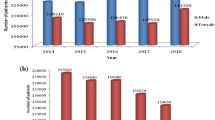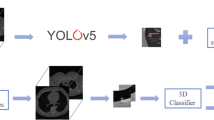Abstract
Cancer is one of the leading causes of mortality worldwide, lung cancer being one of the deadliest. Early detection and accurate diagnosis of lung nodules can save many lives and resources. Number of diagnostic radiology utilized for detection of lung nodules of which computed tomography (CT) scans provide better discernment of disease, thus explored extensively for the automatic nodule analysis. However, manual analysis of radiological images is time-consuming and prone to human errors like detection and interpretation errors. On the other hand, computer-aided detection and diagnosis (CAD) system eliminates manual process and problems associated with it. In this work, an analytical review on various CAD systems for detection and characterization of lung nodules using CT scan images is discussed. A detailed structure of each component of CAD system is presented. Diverse CAD systems which are developed on the basis of state-of-the-art convolutional neural networks (CNN), such as 3D-CNN, transferable CNN, dense convolutional binary tree network, gated dilated network, and mask region CNN, are addressed. The algorithms performance is compared based on metrics: sensitivity (SEN), accuracy (ACC), area under curve (AUC), etc. In order to develop more robust end-to-end system, coupling between detection and diagnostic components is also explored. Finally, current challenges faced in analysis and characterization of lung nodule by the present system and future research opportunities in this field are discussed.
Access this chapter
Tax calculation will be finalised at checkout
Purchases are for personal use only
Similar content being viewed by others
References
WHO Report on Cancer, Setting Priorities, Investing Wisely and Providing Care for All,World Health Organization, Geneva, Switzerland. (2020).
Ozdemir, O., Russell, R. L., & Berlin, A. A. (2020). A 3D probabilistic deep learning system for detection and diagnosis of lung cancer using low-dose CT scans. IEEE Transactions on Medical Imaging, 39(5), 1419–1429. https://doi.org/10.1109/TMI.2019.2947595
Siegel, R. L., Miller, K. D., & Jemal, A. (2020). Cancer statistics, 2020. Cancer Journal for Clinicians, 70(1), 7–30. https://doi.org/10.3322/caac.21590
De Koning, H. J. (2020). Reduced lung-cancer mortality with volume CT screening in a randomized trial. New England Journal of. Medicine, 382(6), 503–513. https://doi.org/10.1056/nejmoa1911793
Snoeckx, A., Reyntiens, P., Desbuquoit, D., Spinhoven, M. J., Van Schil, P. E., Meerbeeck, J. P., & Parizel, P. M. (2018). Evaluation of the solitary pulmonary nodule: Size matters, but do not ignore the power of morphology. Insights into Imaging, 9(1), 73–86.
Zhou, Q. (2016). China national guideline of classification, diagnosis and treatment for lung nodules. Zhongguo Zhi, 19(12), 793–798. https://doi.org/10.3779/j.issn.1009-3419.2016.12.12
Cressman, S. (2017). The cost-effectiveness of high-risk lung cancer screening and drivers of program efficiency. Journal of Thoracic Oncology, 12(8), 1210–1222. https://doi.org/10.1016/j.jtho.2017.04.021
Gu, J., Tian, Z., & Qi, Y. (2020). Pulmonary nodules detection based on deformable convolution. IEEE Access, 8, 16302–16309. https://doi.org/10.1109/ACCESS.2020.2967238
Hussein, S., Kandel, P., Bolan, C. W., Wallace, M. B., & Bagci, U. (2019). Lung and pancreatic tumour characterization in the deep learning era: Novel supervised and unsupervised learning approaches. IEEE Transactions on Medical Imaging, 38(8), 1777–1787. https://doi.org/10.1109/TMI.2019.2894349
Tong, C., et al. (2021). Pulmonary nodule classification based on heterogeneous features learning. IEEE Journal on Selected Areas in Communications, 39(2), 574–581. https://doi.org/10.1109/JSAC.2020.3020657
Ye, Y., Tian, M., Liu, Q., & Tai, H.-M. (2020). Pulmonary nodule detection using v-net and high-level descriptor based SVM classifier. IEEE Access, 8, 176033–176041. https://doi.org/10.1109/ACCESS.2020.3026168
Ali, I., Muzammil, M., Haq, I. U., Khaliq, A. A., & Abdullah, S. (2020). Efficient lung nodule classification using transferable texture convolutional neural network. IEEE Access, 8, 175859–175870. https://doi.org/10.1109/ACCESS.2020.3026080
Gong, L., Jiang, S., Yang, Z., et al. (2019). Automated pulmonary nodule detection in CT images using 3D deep squeeze-and-excitation networks. International Journal of Computer Assisted Radiology and Surgery, 14, 1969–1979. https://doi.org/10.1007/s11548-019-01979-1
Su, Y., Li, D., & Chen, X. (2020). Lung nodule detection based on faster R-CNN framework. Computer Methods and Programs in Biomedicine. https://doi.org/10.1016/j.cmpb.2020.105866
Cai, L., Long, T., Dai, Y., & Huang, Y. (2020). Mask R-CNN-based detection and segmentation for pulmonary nodule 3D visualization diagnosis. IEEE Access, 8, 44400–44409. https://doi.org/10.1109/ACCESS.2020.2976432
Harsono, I. W., Liawatimena, S., & Cenggoro, T. W. (2020). Lung nodule detection and classification from Thorax CT-scan using RetinaNet with transfer learning. Journal King Saud University-Computer and Information Sciences. https://doi.org/10.1016/j.jksuci.2020.03.013. ISSN 1319-1578.
Shi, Y., Li, H., Zhang, H., Wu, Z., & Ren, S. (2020). Accurate and efficient LIF-Nets for 3D detection and recognition. IEEE Access, 8, 98562–98571. https://doi.org/10.1109/ACCESS.2020.2995886
Masood, A., et al. (2020). Automated decision support system for lung cancer detection and classification via enhanced RFCN with multilayer fusion RPN. IEEE Transactions on Industrial Informatics, 16(12), 7791–7801. https://doi.org/10.1109/TII.2020.2972918
Kuo, C-F. J., Huang, C-C., Siao, J-J., Hsieh, C-W., Huy, V. Q., Ko, K-H., & Hsu, H-H. (2020). Automatic lung nodule detection system using image processing techniques in computed tomography. Biomedical Signal Processing and Control, 56, 101659. https://doi.org/10.1016/j.bspc.2019.101659. ISSN 1746-8094.
Rey, A., Arcay, B., & Castro, A. (2020). A hybrid CAD system for lung nodule detection using CT studies based in soft computing. Expert Systems with Applications, 114259. https://doi.org/10.1016/j.eswa.2020.114259. ISSN 0957-4174.
Zheng, S., Cui, X., Vonder, Raymond, M., Veldhuis, N. J., Ye, Z., Vliegenthart, R., Oudkerk, M., & van Ooijen, P. M. A. (2020). Deep learning-based pulmonary nodule detection: Effect of slab thickness in maximum intensity projections at the nodule candidate detection stage. Computer Methods and Programs in Biomedical, 196, 105620. https://doi.org/10.1016/j.cmpb.2020.105620. ISSN 0169-2607.
Suresh, S., & Mohan, S. (2019). NROI based feature learning for automated tumor stage classification of pulmonary lung nodules using deep convolutional neural networks. Journal of King Saud University-Computer and Information Sciences. https://doi.org/10.1016/j.jksuci.2019.11.013. ISSN 1319-1578.
Al-Shabi, M., Lee, H. K., & Tan, M. (2019). Gated-dilated networks for lung nodule classification in CT scans. IEEE Access, 7, 178827–178838. https://doi.org/10.1109/ACCESS.2019.2958663
Veasey, B. P., Broadhead, J., Dahle, M., Seow, A., & Amini, A. A. (2020). Lung nodule malignancy prediction from longitudinal CT scans with siamese convolutional attention networks. IEEE Open Journal of Engineering in Medicine and Biology, 1, 257–264. https://doi.org/10.1109/OJEMB.2020.3023614
Li, X., Li, B., Liu, F., Yin, H., & Zhou, F. (2020). Segmentation of pulmonary nodules using a GMM fuzzy C-Means algorithm. IEEE Access, 8, 37541–37556. https://doi.org/10.1109/ACCESS.2020.2968936
Sun, Y., Tang, J., Lei, W., & He, D. (2020). 3D Segmentation of pulmonary nodules based on multi-view and semi-supervised. IEEE Access, 8, 26457–26467. https://doi.org/10.1109/ACCESS.2020.2971542
Xie, Y., et al. (2019). Knowledge-based collaborative deep learning for benign-malignant lung nodule classification on chest CT. IEEE Transactions on Medical Imaging, 38(4), 991–1004. https://doi.org/10.1109/TMI.2018.2876510
Li, G., et al. (2020). Study on the detection of pulmonary nodules in CT images based on deep learning. IEEE Access, 8, 67300–67309. https://doi.org/10.1109/ACCESS.2020.2984381
Zhang, Q., & Kong, X. (2020). Design of automatic lung nodule detection system based on multi-scene deep learning framework. IEEE Access, 8, 90380–90389. https://doi.org/10.1109/ACCESS.2020.2993872
Gu, X., Xie, W., Fang, Q., Zhao, J., & Li, Q. (2020). The effect of pulmonary vessel suppression on computerized detection of nodules in chest CT scans. Medical Physics, 47, 4917–4927. https://doi.org/10.1002/mp.14401
Shaukat, F., Raja, G., Ashraf, R., et al. (2019). Artificial neural network based classification of lung nodules in CT images using intensity, shape and texture features. Journal of Ambient Intelligence and Humanized Computing, 10, 4135–4149. https://doi.org/10.1007/s12652-019-01173-w
Roy, R., Banerjee, P., & Chowdhury, A. S. (2020). A level set based unified framework for pulmonary nodule segmentation. IEEE Signal Processing Letters, 27, 1465–1469. https://doi.org/10.1109/LSP.2020.3016563
Samundeeswari, P., & Gunasundari, R. (2020). A novel multilevel hybrid segmentation and refinement method for automatic heterogeneous true NSCLC nodules extraction. In 2020 5th International Conference on Devices, Circuits and Systems (ICDCS), Coimbatore, India (pp. 226–235). https://doi.org/10.1109/ICDCS48716.2020.243586
Gong, J., Liu, J., Wang, L., Sun, X., Zheng, B., & Nie, S. (2018). Automatic detection of pulmonary nodules in CT images by incorporating 3D tensor filtering with local image feature analysis. Physica Medica, 46, 124–133. https://doi.org/10.1016/j.ejmp.2018.01.019. ISSN 1120-1797.
Chung, H., Ko, H., Jeon, S. J., Yoon, K. H., & Lee, J. (2018). Automatic lung segmentation with Juxta-Pleural nodule identification using active contour model and bayesian approach. IEEE Journal of Translational Engineering in Health and Medicine, 6, 1–13, 1800513. https://doi.org/10.1109/JTEHM.2018.2837901
Wang, B., et al. (2020). A fast and efficient CAD system for improving the performance of malignancy level classification on lung nodules. IEEE Access, 8, 40151–40170. https://doi.org/10.1109/ACCESS.2020.2976575
Gong, Z., Li, D., Lin, J., Zhang, Y., & Lam, K.-M. (2020). Towards accurate pulmonary nodule detection by representing nodules as points with high-resolution network. IEEE Access, 8, 157391–157402. https://doi.org/10.1109/ACCESS.2020.3019104
Zheng, S., Guo, J., Cui, X., Veldhuis, R. N. J., Oudkerk, M., & van Ooijen, P. M. A. (2020). Automatic pulmonary nodule detection in CT scans using convolutional neural networks based on maximum intensity projection. IEEE Transactions on Medical Imaging, 39(3), 797–805. https://doi.org/10.1109/TMI.2019.2935553
Monkam, P., et al. (2019). Ensemble learning of multiple-view 3D-CNNs model for micro-nodules identification in CT images. IEEE Access, 7, 5564–5576. https://doi.org/10.1109/ACCESS.2018.2889350
Chenyang, L., & Chan, S.-C. (2020). A joint detection and recognition approach to lung cancer diagnosis from CT images with label uncertainty. IEEE Access, 8, 228905–228921. https://doi.org/10.1109/ACCESS.2020.3044941
Zhou, Z., Li, S., Qin, G., Folkert, M., Jiang, S., & Wang, J. (2020). Multi-Objective based radiomic feature selection for lesion malignancy classification. IEEE Journal of Biomedical and Health Informatics, 24(1), 194–204. https://doi.org/10.1109/JBHI.2019.2902298
Khan, S. A., Nazir, M., Khan, M. A., et al. (2019). Lungs nodule detection framework from computed tomography images using support vector machine. Microscopy Research and Technique, 82, 1256–1266. https://doi.org/10.1002/jemt.23275
Sahu, P., Yu, D., Dasari, M., Hou, F., & Qin, H. (2019). A lightweight multi-section CNN for lung nodule classification and malignancy estimation. IEEE Journal of Biomedical and Health Informatics, 23(3), 960–968. https://doi.org/10.1109/JBHI.2018.2879834
Wang, W., et al. (2019). Nodule-Plus R-CNN and deep self-paced active learning for 3D instance segmentation of pulmonary nodules. IEEE Access, 7, 128796–128805. https://doi.org/10.1109/ACCESS.2019.2939850
Saba, T., Sameh, A., Khan, F., et al. (2019). Lung nodule detection based on ensemble of hand crafted and deep features. Journal of Medical Systems, 43, 332. https://doi.org/10.1007/s10916-019-1455-6
Zhang, B., et al. (2019). Ensemble learners of multiple deep CNNs for pulmonary nodules classification using CT images. IEEE Access, 7, 110358–110371. https://doi.org/10.1109/ACCESS.2019.2933670
Zhai, P., Tao, Y., Chen, H., Cai, T., & Li, J. (2020). Multi-Task learning for lung nodule classification on chest CT. IEEE Access, 8, 180317–180327. https://doi.org/10.1109/ACCESS.2020.3027812
Cao, H., et al. (2019). Multi-Branch ensemble learning architecture based on 3D CNN for false positive reduction in lung nodule detection. IEEE Access, 7, 67380–67391. https://doi.org/10.1109/ACCESS.2019.2906116
Armato, S. G. (2011). The lung image database consortium (LIDC) and image database re-source initiative (IDRI): A completed reference database of lung nodules on CT scans. Medical Physics, 38(2), 915–931. https://doi.org/10.1118/1.3528204
NLST Datasets. Accessed: Aug. 15, 2020. [Online]. Available: https://cdas.can-cer.gov/datasets/nlst/
VIA/I-ELCAP Datasets. Accessed: Aug. 15, 2020. [Online]. Available: http://www.via.cornell.edu/databases/lungdb.html
Ru Zhao, Y., Xie, X., de Koning, H. J., Mali, W. P., Vliegenthart, R., & Oudkerk, M. (2011). NELSON lung cancer screening study. Cancer Imaging, 11(1A), S79–S84. https://doi.org/10.1102/1470-7330.2011.9020
Tan, M., Wu, F., Yang, B., Ma, J., Kong, D., Chen, Z., & Long, D. (2020). Pulmonary nodule detection using hybrid two-stage 3D CNNs. Medical Physics, 47, 3376–3388. https://doi.org/10.1002/mp.14161
Kuang, Y., Lan, T., Peng, X., Selasi, G. E., Liu, Q., & Zhang, J. (2020). Unsupervised multi-discriminator generative adversarial network for lung nodule malignancy classification. IEEE Access, 8, 77725–77734. https://doi.org/10.1109/ACCESS.2020.2987961
Masood, A., et al. (2020). Cloud-Based automated clinical decision support system for detection and diagnosis of lung cancer in chest CT. IEEE Journal of Translational Engineering in Health and Medicine, 8, 1–13, 4300113. https://doi.org/10.1109/JTEHM.2019.2955458
Author information
Authors and Affiliations
Corresponding author
Editor information
Editors and Affiliations
Rights and permissions
Copyright information
© 2022 The Author(s), under exclusive license to Springer Nature Singapore Pte Ltd.
About this paper
Cite this paper
Ali, N., Yadav, J. (2022). Computer-Aided Detection and Diagnosis of Lung Nodules Using CT Scan Images: An Analytical Review. In: Gupta, D., Khanna, A., Kansal, V., Fortino, G., Hassanien, A.E. (eds) Proceedings of Second Doctoral Symposium on Computational Intelligence . Advances in Intelligent Systems and Computing, vol 1374. Springer, Singapore. https://doi.org/10.1007/978-981-16-3346-1_44
Download citation
DOI: https://doi.org/10.1007/978-981-16-3346-1_44
Published:
Publisher Name: Springer, Singapore
Print ISBN: 978-981-16-3345-4
Online ISBN: 978-981-16-3346-1
eBook Packages: Intelligent Technologies and RoboticsIntelligent Technologies and Robotics (R0)




